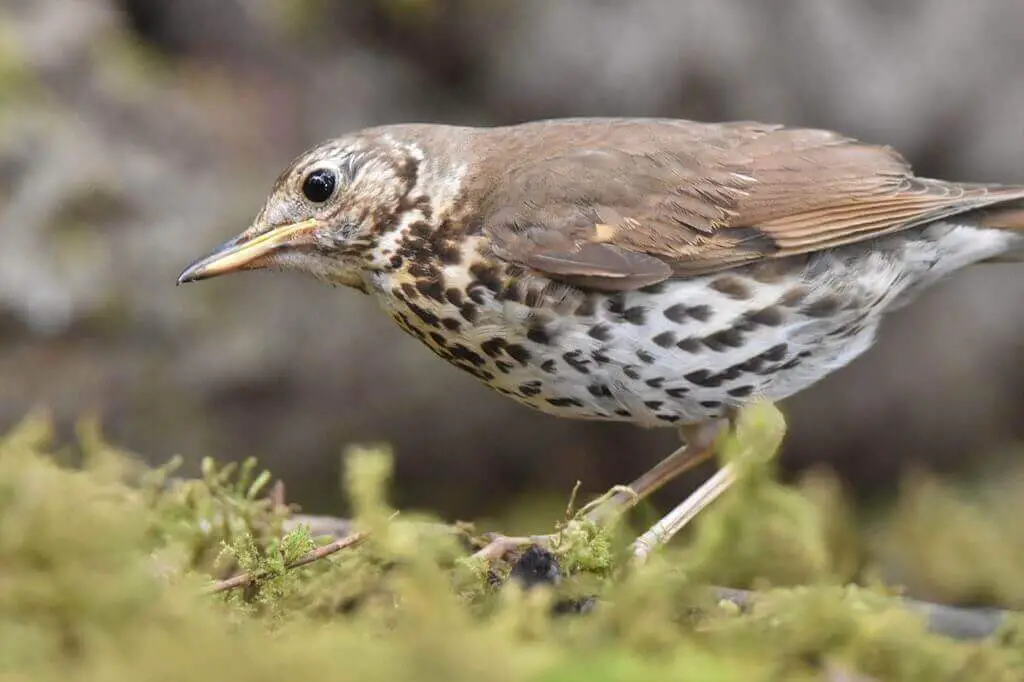
How to Attract Thrushes to Your Garden? Get ready to welcome these delightful feathered visitors with open wings!
Whether you’re a bird enthusiast or simply want to add a touch of nature to your backyard, this article has got you covered.
Discover simple yet effective tips and tricks to create a thriving haven for thrushes. So, grab your binoculars and let’s dive into the world of these charming songbirds!
Table of Contents
Key Takeaways
- Create a welcoming habitat: Provide a mix of trees, shrubs, and ground cover to mimic natural woodland environments that thrushes prefer.
- Offer a diverse food supply: Plant native berry-producing shrubs and trees, as well as provide sources of insects and worms, to cater to thrushes’ varied diets.
- Provide fresh water: Install a bird bath or shallow water feature to attract thrushes and other birds seeking hydration and bathing opportunities.
- Limit pesticide use: Minimize the use of harmful chemicals in your garden to protect thrushes and their food sources from contamination.
- Offer shelter and nesting sites: Provide dense vegetation and suitable nesting structures like birdhouses to encourage thrushes to establish their homes in your garden.
- Minimize disruptions: Reduce noise and human activity near the garden to create a peaceful environment that thrushes find inviting.
- Be patient and observant: It may take time for thrushes to discover and trust your garden. Patience and careful observation will help you appreciate their presence when they do visit.
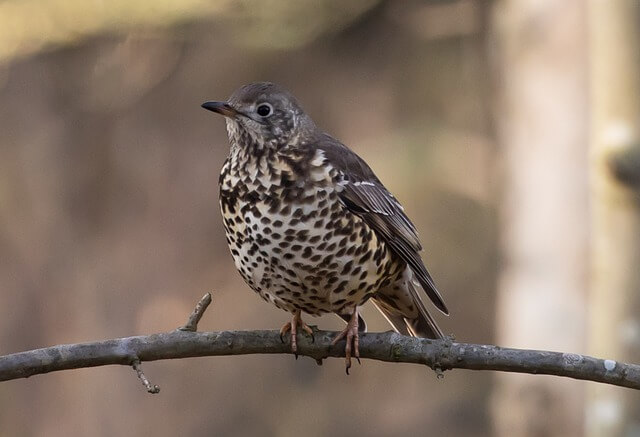
North America’s 9 Thrush Species
North America is home to a diverse array of thrush species, each with its own unique characteristics and preferences.
These nine species of thrushes bring their enchanting melodies and vibrant presence to various habitats across the continent.
From the tranquil forests and woodlands favored by the Hermit Thrush and Swainson’s Thrush to the high-elevation realms where the elusive Bicknell’s Thrush resides, these birds have adapted to thrive in their specific environments.
Their diets range from feasting on insects to relishing the sweet bounty of berries and fruits.
Whether it’s the soothing notes of the Wood Thrush or the striking coloration of the Varied Thrush, each species adds its own charm to North America’s avian tapestry.
Exploring the habitat, diet, size, and coloration of these thrushes offers a glimpse into the fascinating world of these captivating birds.
| Thrush Species | Habitat | Diet | Size | Coloration |
|---|---|---|---|---|
| Hermit Thrush | Forests, woodlands | Insects, berries | Small to medium | Brown with spotted |
| Swainson’s Thrush | Woodlands, shrublands | Insects, fruits | Small to medium | Brown with buffy eyering |
| Bicknell’s Thrush | High-elevation forests | Insects, berries | Small to medium | Brown with spotted |
| Wood Thrush | Forests, thickets | Insects, fruits | Medium | Rusty brown with spots |
| Gray-cheeked Thrush | Tundra, boreal forests | Insects, berries | Small to medium | Gray-brown with streaks |
| Varied Thrush | Forests, mountains | Insects, berries | Medium | Orange, black, and white |
| Aztec Thrush | Forests, mountains | Insects, fruits | Medium | Brown with pale throat |
| Red-legged Thrush | Forests, gardens | Insects, fruits | Medium | Brown with red legs |
| Song Thrush | Woodlands, gardens | Insects, fruits | Medium | Brown with spotted |
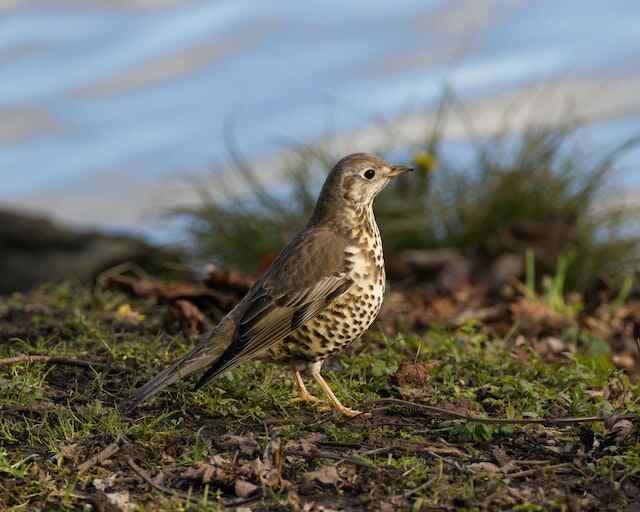
How to Attract Thrushes to your Garden
Unlock the secrets of attracting thrushes to your garden. Discover expert tips and strategies to create a welcoming habitat that entices these delightful songbirds.
From selecting the right plants to providing their favorite foods, get ready to transform your garden into a thriving thrush haven. Let’s explore how to attract thrushes and enhance your outdoor oasis.
Foods that Attract Thrushes
Thrushes are known for their diverse diet, which includes a wide range of insects, plants, fruits, and berries. To attract thrushes to your garden, it’s essential to provide them with the foods they naturally seek.
Here are some key food sources that can entice thrushes to visit and thrive in your garden:
- Insects: Thrushes are avid insect-eaters and rely on insects for a significant portion of their diet. Beetles, caterpillars, worms, ants, and spiders are among their favorite insect prey. Creating a garden environment that supports a healthy insect population will attract thrushes looking for a reliable food source.
- Plants: Thrushes have a particular affinity for garden plants that bear fruits and berries. They enjoy feasting on native shrubs and trees that produce berries such as elderberries, holly, serviceberries, and sumac. Incorporating these plants into your garden landscape will provide a natural food source that appeals to thrushes.
- Fruits and Berries: Along with garden plants, thrushes are attracted to ripe fruits and berries. Planting fruit-bearing trees and shrubs such as mulberries, blueberries, raspberries, and blackberries will not only enhance the aesthetic appeal of your garden but also attract thrushes with their delicious offerings.
- Mealworms: If you want to go the extra mile to entice thrushes to your garden, consider offering mealworms. These high-protein treats are a favorite of many bird species, including thrushes. You can place mealworm feeders or scattered mealworms in strategic locations to provide an additional food source for these birds.
Remember that providing a variety of food sources is key to attracting thrushes to your garden. By incorporating native plants, creating an insect-friendly environment, and offering fruits, berries, and even mealworms, you can create an enticing buffet that will make your garden a favorite destination for these delightful birds.
Install a Bird Feeder for Thrushes
Setting up a bird feeder near your yard is a great way to attract thrushes and enjoy their presence.
Thrushes are not aggressive birds, making them ideal feeder visitors. One of their favorite foods is sunflower seeds, so placing some on a platform or tray feeder will entice them.
For the best results, consider using the Squirrel Buster suet feeder. This feeder is designed to keep squirrels at bay while allowing thrushes easy access to the food.
Peanut butter suet cakes are particularly appealing to thrushes due to their taste. You can find both the Squirrel Buster suet feeder and peanut butter suet cakes on platforms like Amazon.
By providing a bird feeder with their preferred foods, you increase the chances of attracting thrushes to your garden and creating a welcoming environment for these delightful birds.
Install a Thrush-friendly Birdbath
Setting up a birdbath in your garden is an excellent way to attract thrushes and provide them with a source of water for drinking and bathing.
Thrushes, like many other bird species, are attracted to water and enjoy splashing around and preening their feathers.
When selecting a birdbath, it is important to choose a quality product that meets the birds’ needs.
Consider purchasing a birdbath such as the Best Choice Birdbath, which has received positive reviews for its design and functionality.
You can find this product on Amazon and explore other options that suit your preferences and budget.
To make your birdbath more appealing to thrushes, ensure that it is placed in a suitable location within your garden.
Ideally, position it in a quiet and secluded area away from direct sunlight, as thrushes prefer a calm and shaded environment.
Additionally, keep the birdbath clean and provide fresh water regularly to attract and maintain the interest of thrushes and other bird species.
By incorporating a birdbath into your garden, you create an inviting space for thrushes to drink, bathe, and enjoy the water.
It adds an element of beauty to your outdoor space while providing a vital resource for these delightful birds.
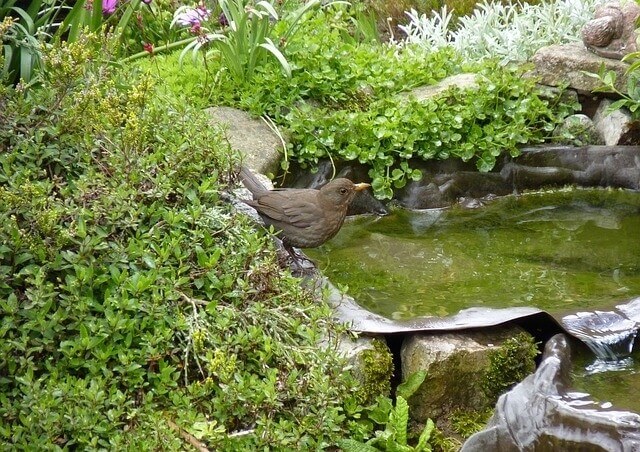
Inviting Homes: Birdhouses for Thrushes
Setting up a birdhouse (nesting box) is an effective and simple way to attract thrushes to your garden.
These beautiful birds are naturally drawn to cozy and sheltered spaces, and a birdhouse provides them with the perfect nesting spot.
Birdhouses offer protection from rain and cold winds, providing a safe haven for thrushes to build their nests and raise their young.
By providing a birdhouse, you create a welcoming environment that thrushes will return to year after year.
When choosing a birdhouse, opt for one made from cedar, as it offers durability and natural resistance to decay.
One recommended model is the Nature’s Way Birdhouse, which has proven to be successful in attracting thrushes.
Remember to place the birdhouse in an appropriate location, ideally in areas where thrushes frequently gather.
Provide a clear and unobstructed flight path to the birdhouse, ensuring that it is easily accessible for the birds.
With a well-placed and suitable birdhouse, you can create a comfortable and secure space that thrushes will happily call their own in your garden.
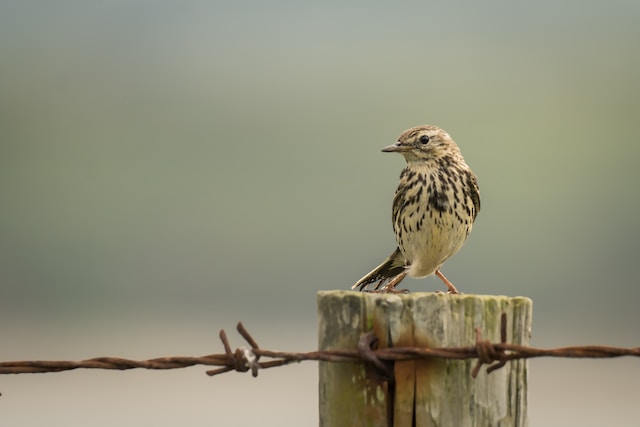
Attracting Thrushes with Plants
If you want to create an inviting habitat for thrushes in your garden, incorporating the right plants can make all the difference. Thrushes are attracted to a variety of plants that provide them with food and shelter.
Here are some plant species that are known to attract thrushes:
- Gray Dogwood (Cornus racemosa): Thrushes are particularly fond of the fruits produced by gray dogwood. The clusters of white flowers in spring also add beauty to your garden.
- Flowering Dogwood (Cornus florida): This popular ornamental tree not only adds visual appeal with its beautiful flowers but also produces red fruits that thrushes find irresistible.
- Silky Dogwood (Cornus amomum): Another dogwood species, silky dogwood produces bluish-black fruits that attract thrushes. Its dense foliage also provides nesting sites and shelter.
- Elderberry (Sambucus spp.): Elderberry shrubs produce clusters of small dark berries that thrushes find highly appealing. They also offer cover and nesting opportunities.
- Sumac (Rhus spp.): The vibrant red fruits of sumac are a favorite among thrushes. This low-maintenance shrub also provides dense foliage for nesting and protection.
- Winterberry (Ilex verticillata): Winterberry shrubs produce bright red berries during the winter, making them an important food source for thrushes when other options are limited.
- Gooseberry (Ribes spp.): Thrushes are known to feed on the sweet and tart fruits of gooseberry bushes. These shrubs also provide a safe place for nesting.
- Currants (Ribes spp.): Similar to gooseberries, currant bushes produce small, flavorful fruits that attract thrushes. Their dense foliage offers nesting opportunities as well.
- Raspberry (Rubus spp.): Thrushes enjoy the juicy fruits produced by raspberry canes. The thorny thickets also provide protection and nesting sites.
- Cranberry (Vaccinium macrocarpon): Cranberry plants not only add a pop of color to your garden, but also produce berries that thrushes may feed on during the fall and winter.
- Nannyberry (Viburnum lentago): The dark blue-black fruits of the nannyberry shrub are a valuable food source for thrushes. Its dense growth makes it an ideal shelter.
By including a combination of these plants in your garden, you can create an attractive and beneficial environment for thrushes.
Remember to provide a variety of plant species that produce fruits and berries at different times of the year to ensure a consistent food supply for these beautiful birds.
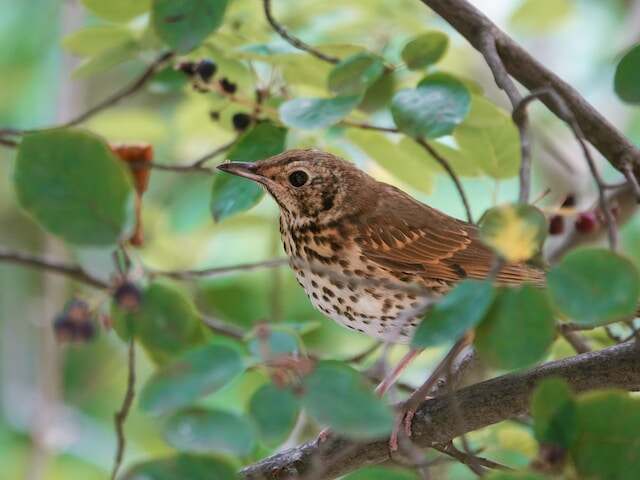
Enhancing Thrush Attraction: Extra Tips and Tricks
- Offer different types of seeds: sunflower, safflower, millet and corn.
- Plant shrubs in a row that will provide shelter from predators
- Cut up apples or pears into bite-sized pieces and place them at the base of a tree. Fruit is a favorite food of thrushes, and they are likely to stop by your yard for an easy meal.
- Maintain good sanitation of the feeders and birdbaths. Remove the droppings daily and wipe down the bird feeders often to eliminate any droppings left over from the previous day.
- Enticing these birds to your yard can take time so it is best to be patient. They are quite capable of moving quite quickly and that means that you may not see them immediately.
- If you want to get them to stay, you are going to have to offer them a place that they are going to feel safe. This can often mean providing them with some kind of cover like a nesting box, or even a tree nearby.
- Don’t use pesticides or herbicides around your yard; this will kill insects they feed on.
Frequently Asked Questions
What month do thrushes lay eggs?
The time of year when these animals start to reproduce depends on the location. For example, in colder climates, such as Canada and Russia, they will not start laying eggs until late winter or early spring. Whereas in warmer regions such as Florida and Costa Rica, it’s thought they may begin laying eggs during December or January.
Do thrushes eat bread?
The answer is yes, but in a limited capacity. Thrushes do consume some types of food that can be found near humans, such as insects and worms. They also will feed on anything they find while foraging such as bread crumbs, seeds, berries and other fruits.
Do thrushes pair for life?
Many people believe that thrushes mate for life and will never find another partner if their mate dies. However, it turns out that these birds do not actually mate for life and instead choose new mates every year.
Do thrushes eat mealworms?
The answer to these questions is yes, thrushes do in fact eat meal worms. They are omnivores, which means they will feed on both plant and animal matter as well as any other items such as worms or fruit that may be available.
Which thrush is the biggest?
Mistle thrushes are the largest of all thrush species. They measure about 11″ inches in length and they live in Europe and Asia.

